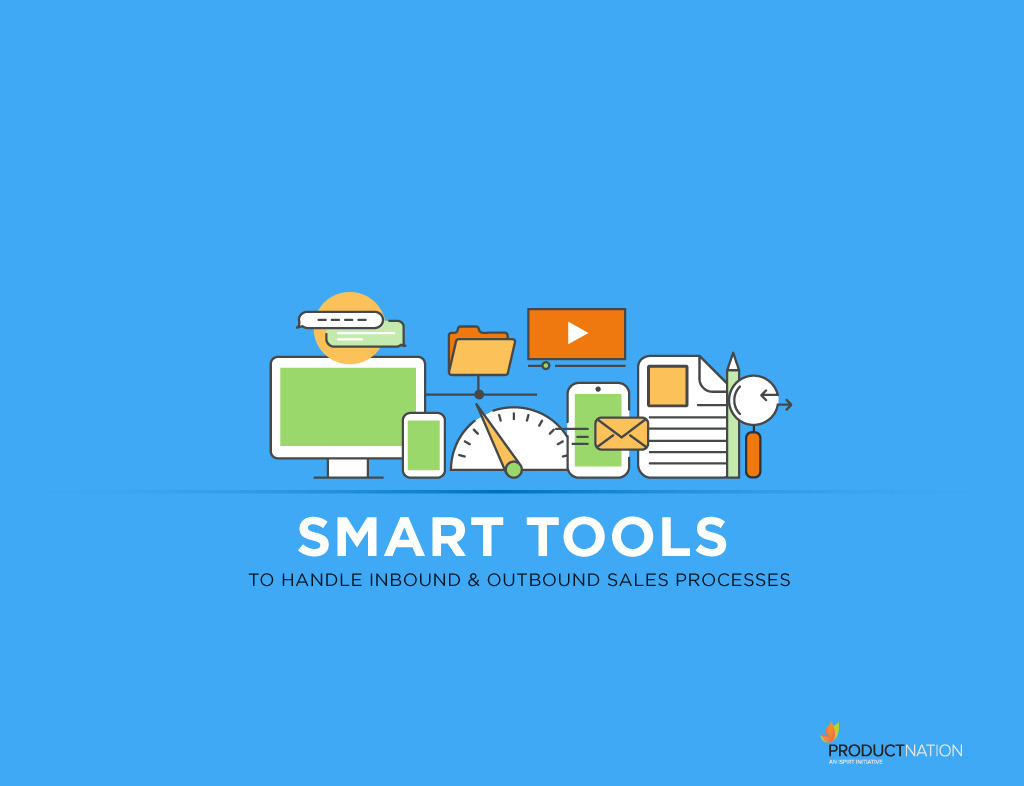When #iSPIRT announced a roundtable on ‘Building & Scaling Growth Teams for Saas Founders’ with Ashwin Ramesh (Synup) leading it, I was thrilled to join it, assuming it would be a direct take off from Ashwin’s session at #SaaSx4. Well, we were not disappointed. I am sure the other participants share my feelings on the outcome – It was an action-packed interactive session on the strategies one can use to be successful in SaaS.
Most fellow founders who joined the discussion chimed up with a common theme, with questions on how to get good inbound leads, how to scale up, crack the game, and most importantly – how to switch from outbound to inbound.
In this post, I want to provide a summary of all the tools that were discussed in the roundtable to help in content creation and distribution, and tools that will help you do outbound in a structured way. The sheer number of tools that we discussed was overwhelming to the group, to say the least.
 Content is still King, so let’s lead with it.
Content is still King, so let’s lead with it.
Content: Good content is more important than the fact that it is a blog or a post or guest post. It could be anything that attracts folks, and gives your product or service the attention span needed. Some of the examples of good content that were discussed include websites, checklists (e.g. http://localseochecklist.org/), videos, visualisations, infographics, data driven content, Quora ads, & Answers wiki.
If you need ideas on how to create great content, take a look at https://tympanus.net/codrops/.
Now that you have the content, let’s shift the focus to distribution. The traditional models of distribution have become saturated. No one’s going to come just because you wrote and published something. So you need to come up with innovative ways to distribute content. Well written content, if it is not reaching the intended audience, is a dead investment and one has to have deliberate policy of setting aside a budget, even if it’s a small one, for distribution of each piece of content. You should try the following options:
- Start contributing on reddit, and especially to a subreddit specific to your industry, business area or technology. The strategy suggested is to become active participants of a specific community, engage in discussions, post comments, contribute and build your credibility. The content you may share here would be actively promoted by other participants and also gets picked up other channels. The key is to build credibility and be supportive to other members.
- Another idea is to sign up to https://inbound.org/ and once again be an active participant, and a slowly become a regular contributor.
- A third option is to use services like QUUU to distribute or share content across social media including Twitter , Facebook.
- Investing in FB paid ads also has been found effective for many businesses.
- If you feel that the above strategy is high on investment and low on initial results, start using article syndication services like Outbrain or Taboola to engage your target audience while they are browsing or reading interesting content on the web.
- A good way to use Taboola or Outbrain would be to use it with Bombora, one of the best B2B intent engines. It gives you better options to identify / reach your B2B customers. There are integrations available for Bombora with Outbrain, and you need to decide on the budget.
- If you need to reach out to key influencers to help you share your content on a wider scale, use Buzzsumo to build the list and also get an idea about what your competition is sharing.
- Once you have the list, use Buzzstream to manage the outreach that is desired. It helps manage the relationships and also monitor the content sharing.
- One related area which may be of benefit is to reach out to journalists using tools like Haro and Bite Size PR.
- If you have good content, you can choose to distribute the same through newsletters. Look for a curated list of newsletter sites or owners and get your content into these newsletters. It is an ongoing challenge for newsletter publishers to get good content for their readers, so reaching out to provide them content becomes a win-win proposition
Social media is a powerful medium for reaching out to a wider audience. Tools that may be used for leveraging social media audience are:
- Lead Sift ( twitter ) – This is used to keep track of potential customer who are engaged by your competition . Helps in qualification of leads and setting up engagements faster
- EngageWise : To help present your content to a wider audience based on the interest they show in similar content. This helps in growing the pipeline using the reach of social media.
- Lead Feeder : Identifies the visitors to the website thereby qualifying the visitors and makes better / faster engagement possible. Offers and integration to CRM as well.
- Ad Espresso : One can create and test FB Ads in a very short time and run ad campaigns instead of single ads to effectively reach the different sections of audience thereby reducing cost and increasing efficacy of the ad.
Any website / online content strategy has to consider SEO. Some of the tools that can be used for SEO include ( apart from the tools offered by Google )
- Screaming Frog – This can be used for in-depth technical analysis on your site . It is a website crawler, works very fast & quickly allows one to analyse the results in real-time.
- All in one SEO : It can be used to optimize WordPress site for SEO.
Another key element of growth involves reaching out to prospective customers. For that , email is still the most effective mechanism. When it comes to using outbound emailing, getting good data ( email ids ) is equally important as the mail content and delivery strategy .
For Creating the Data ( emails ) the options available are
- Scrape websites for data
- Screaming frog : The custom extraction feature allows you to scrape any data from the HTML of a web page using CSS Path, XPath and regex
- Scrappy : An open source and collaborative framework for extracting the data you need from websites, in a fast, simple, yet extensible way.
- Some other common tools are
- Builtwith : One may get to see leads in your list by known technology spend, the usage or non-usage of competitor or other technologies as well as the usage or non-usage of entire categories of technologies like A/B Testing.
- Limeleads : Access to a large repository of business leads across multiple verticals
- Zoominfo : ZoomInfo’s Growth Acceleration Platform offers the most accurate and actionable B2B contact and company intelligence
- Buy data from publishers like D&B . This link is useful for Indian websites only.
Once you have the data , cleansing or cleaning up email list is the next key activity
- External agencies may be employed to clean up the email list. There are many service providers engaged in doing this for an acceptable consideration.
Once the email list has been curated, then you have to decide on the best way to engage the prospects or identify a delivery mechanism. There are many tools which support a structured approach to sending mails in a personalised manner, away from the mass mailers.
- Klenty : This is an outbound sales automation tool for your inside sales team to prospect, outreach and follow up at scale.
- Prospect : A simple tool for sales automation. Works well for cold emailing and drip marketing.
- Quickmail : Another simple tool to automate outbound emails.
- Outreach : Yet another platform that supports emailing and calling.
Any inbound process revolves around the sales funnel. Organisations constantly look for increasing the conversation across all stages of the funnel or improve the funnel itself. Some of the recommendations that came out of the extensive discussion included usage of Google Analytics and other exclusive tools for understanding the user’s journey in your website and app through session recordings, heat map analysis, etc. It would be good if cohorts are defined before initiating analysis so that patterns can be identified.
- Heap: Automatically captures every user action in your web or iOS app and lets you analyze it all retroactively.
- MixPanel: Follow the digital footprint of every user across mobile and web devices. Know precisely what happens inside your product.
- Inspectlet: Inspectlet records videos of your visitors as they use your site, allowing you to see everything they do.
- Hotjar: Can be used to understand user behaviour as it visually represents their clicks, taps and scrolling behavior on your website.
- Crazy Egg: Through Crazy Egg’s heat map and scroll map reports you can get an understanding of how your visitors engage with your website.
Other tools that were mentioned include marketing automation tools and A/B testing / multivariate testing tools. One common suggestion which came up was to use best in class tools rather than using all in one kind of tools. A few examples of specific tools are mentioned below. Since all of them are well known, I don’t think it’s necessary to add a description of what they do.
Marketing Automation tools / Communication tools:
A/B – MVT Tools
A big thanks to Ashwin and the roundtable participants for listing these tools and sharing their experiences in using them. I may have missed out one or two of the tools discussed. Look forward to your comments on these tools and also suggestion of other equally valuable tools for inbound / outbound processes.
 Disclosure : I am Neel Padmanabhan part of Team Lucep and head India Operations . Lucep is an instant response call back tool that is currently being used by several businesses around the world for handling inbound leads. The tool is designed to encourage visitors to the website to contact the sales team and get a response as quickly as possible.
Disclosure : I am Neel Padmanabhan part of Team Lucep and head India Operations . Lucep is an instant response call back tool that is currently being used by several businesses around the world for handling inbound leads. The tool is designed to encourage visitors to the website to contact the sales team and get a response as quickly as possible.

